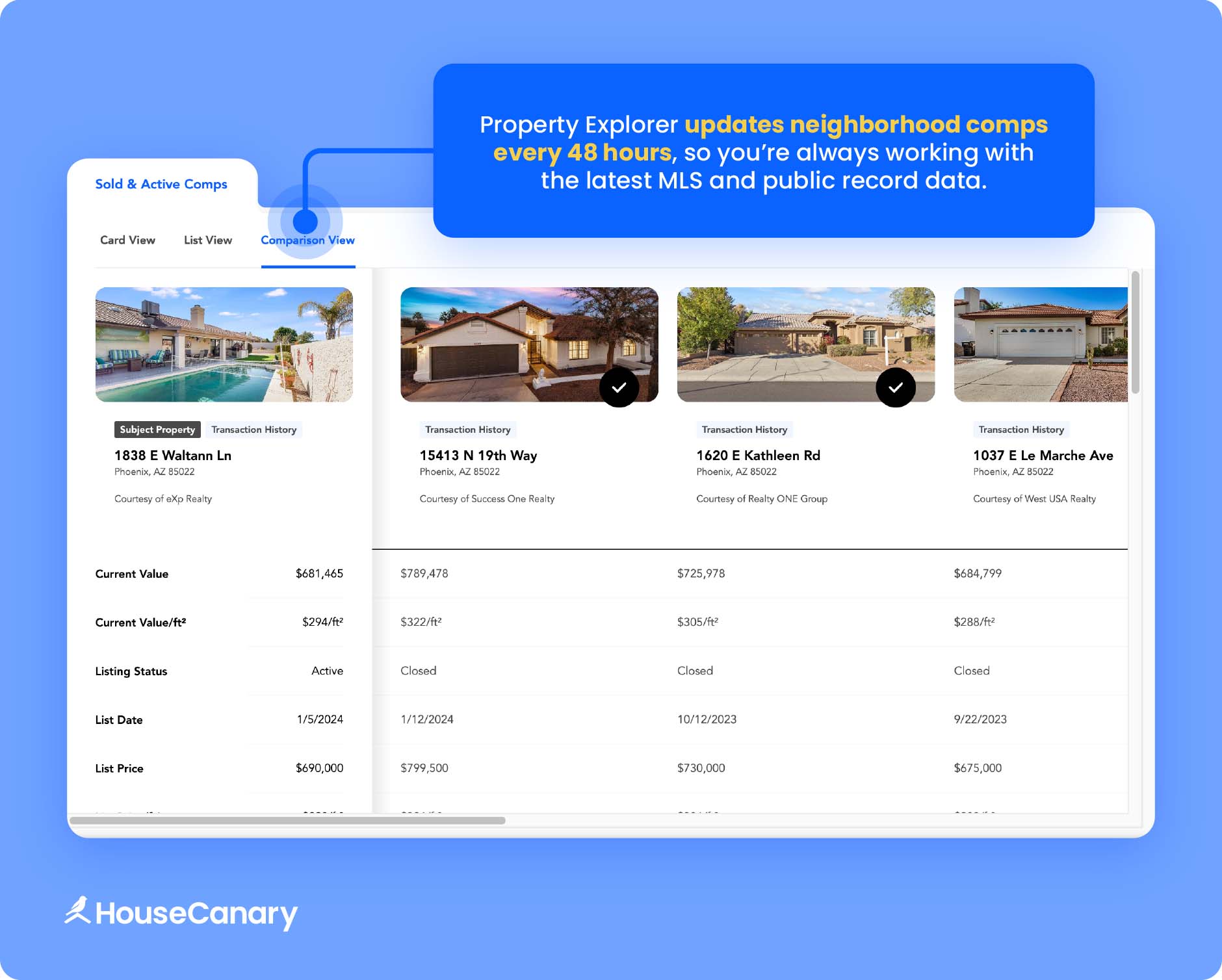
Will the housing market stay hot or finally cool down? According to HouseCanary’s latest housing market forecast, U.S. single-family home prices rose 3% year-over-year through Q3 2025, but signs of a shift are emerging. Inventory just hit a four-year high, price cuts are becoming more common, and rising mortgage rates are pushing many buyers to the sidelines.
In this deep dive into current real estate market trends, we’ll unpack where home prices are headed next, how regional markets are diverging, and what rising inventory means for buyers and sellers. Whether you're an investor, agent, or prospective homeowner, this data-backed snapshot will help you navigate what's coming.
Key Takeaways
- Prices are essentially flat month-over-month: The median listing price barely budged, from $470,560 in May to $470,897 in June, reflecting just a 0.07% MoM increase. This nearly horizontal trend underscores a noticeable cooldown in market momentum.
- Inventory hits a four-year high: Active listings surged 23.1% YoY in June 2025, easing the housing shortage and signaling a shift toward a more balanced market.
- Affordability remains a barrier: With mortgage rates hovering around 7%, monthly payments are up nearly $1,000 vs. low-rate years. Many prospective buyers are pausing, while cash-heavy investors move in.
Housing Market Snapshot: Q3 2025
In 2025, increased demand is shifting toward smaller, more affordable markets, a key trend reshaping the housing market. Housing market predictions fueled by HouseCanary’s data show a 3% year-over-year increase in U.S. home prices through Q3 2025. But national averages only tell part of the story.
Regional trends vary widely, with Midwest and New England cities seeing the strongest growth, while parts of the South, including Florida and Texas, are experiencing flat or declining prices.
Markets like Brunswick, GA (+7.1%), Grand Island, NE (+6.3%), and Glens Falls, NY (+5.9%) are leading the way. Cities such as Jackson, MI, and Rockford, IL, are also gaining momentum, each forecasted to grow over +5.5%.

Are Home Prices Peaking? The Surprising Shift in 2025 Trends
U.S. real estate market trends in 2025 show that home prices are still rising, but signs suggest the peak may be near. In June 2025, the median listing price for single-family homes hit $470,897, a modest 2% increase YoY, while the median closing price grew 2.8% to $449,278. Price per square foot also showed steady gains, and buyer demand remains strong, with contract volume up 6–10% YoY.
However, the market’s tone is shifting. Although the sale-to-list price ratio stays high at around 98%, sellers are reducing prices to stay competitive as inventory builds.
Buyers are still active but showing more resistance to price, prompting more seller concessions. The market is cooling, with slower growth and more balanced conditions emerging. Real estate investment software can help investors stay ahead of these changes by tracking pricing trends and identifying opportunities in changing markets.
Inventory Surge: Is This the End of the Housing Shortage?
The housing shortage that defined the early 2020s is beginning to ease. In June 2025, active listings increased by 23.1% YoY and are up 44.9% compared to 2023. This marks the highest inventory level since 2021, pushing months of inventory to 4.84. The market remains generally neutral but is steadily shifting in favor of buyers.
What’s driving the change? While new listings rose 2.8%, a sharp 30.7% increase in removals caused a slight drop in net new listings. Homes are cycling on and off the market more often, signaling renewed seller activity and more dynamic conditions. At the same time, the median days on marketincreased to 42 from 39 the previous year, giving buyers more options and negotiating power.
Rising Rates, Falling Confidence: Is Homeownership Drifting Out of Reach?
With mortgage rates at 6–7% and prices at record highs, affordability is the lowest it has ever been, shrinking buying power and slowing market demand. Higher monthly payments are forcing many buyers to lower their price range or leave the market entirely.
Buyer dynamics are also shifting:
- First-time buyers are priced out by high costs and down payments.
- Move-up buyers are staying put to keep low interest rates.
- Investors are capitalizing on cash offers and rental strategies.
As rates stay high, homeownership is a difficult goal to reach for many.

2025 Real Estate Pulse Check: Which Cities Are Up, and Which Are on the Decline
As the market settles into a higher-rate environment, regional performance is diverging more than ever. Some cities are showing surprising resilience, while others are seeing sharp slowdowns in price growth and sales activity.
Based on HouseCanary’s predictions:
- Cities on the rise: Mid-sized cities, particularly in Florida, are attracting buyers due to lower taxes, warmer climates, and growing job markets. These areas offer better value and quality of life than high-cost coastal cities.
- Cities facing challenges: High-cost coastal cities like San Francisco and New York are seeing reduced buyer interest as affordability concerns mount.
- Investor interest: Rental properties are becoming more attractive as investors seek stable returns amid stock market volatility.
Tools like Property Explorer can assist investors and real estate professionals in navigating these current real estate market trends. With access to real-time comps, historical price data, and neighborhood-level insights, users can evaluate market conditions, benchmark property values, and make better investment decisions.

Is the Market on the Brink of a Crash?
While a full-blown housing market crash is unlikely in 2025, the market is experiencing significant shifts due to several macroeconomic factors:
- Potential Fed rate cuts: While mortgage rates remain high, a potential easing of Fed policy later in the year could improve affordability and revive sidelined demand.
- Economic uncertainty: Lingering inflation, global instability, and labor market shifts continue to weigh on consumer confidence and housing activity.
- Inventory trends: Active listings are up significantly YoY, helping shift the market toward more balanced conditions.
Rather than a sharp crash, the market is more likely to reach normalization, with slower price growth, more listings, and great opportunities for patient buyers.
Get Ahead of Market Trends with HouseCanary
Data is essential to stay ahead of real estate market trends and ride the wave of an ever-changing market. HouseCanary empowers investors, agents, and brokers with precise, property-level analytics and forecasting tools that drive confident decisions.
With tools like Instant Insights, users can quickly evaluate pricing trends, forecast inventory changes, and assess deal potential. For pricing strategy, our automated valuation model (AVM) delivers real-time property values using MLS data, public records, and frequent model updates.
Ready to get ahead of the market? Get started with HouseCanary today.














.jpeg)








